“(Property of) the palace of Assurnasirpal (II), vice-regent of Assur, chosen of Enlil and Ninurta, beloved of Anu and Dagan, destructive weapon of the great gods, strong king, king of the universe, king of Assyria, son of Tukulti-Ninurta (II), great king, strong king, king of the universe,…”
This is how Ashurnasirpal II, a harsh king, described himself at the beginning of his “Standard Inscription”, which was carved horizontally onto the North-West Palace’s wall reliefs at Nimrud. A real terror of the Middle East, Ashurnasirpal II decisively crushed any revolt, massacred defeated rebels, and even burned children and women after an uprising; heartless and merciless!
The Assyrian literature told us that the North-West Palace of Ashurnasirpal II was a wonder at that time, mid-9th century BCE. The King had feelings to enjoy art! At the heart of the Assyrian Empire, this palace was built as part of a large-scale renovation plan to revive the ancient city of Nimrud (ancient Kalhu; Biblical Calah) in Mesopotamia, modern-day Iraq. The site became the royal residential and administrative city of the Assyrians for almost 150 years.
As in any other building during that time, the walls were composed of mud-bricks, which were reinforced by timber. Then, thick slabs of alabaster covered these walls as sculpted revetments, depicting various scenes, as a film or comic book in stone. The scenes were carved in low reliefs, ranging from superficial incisions to deep cuts. At the upper part of these slabs, a multitude of colorful fresco paintings were inserted; the King had taste!
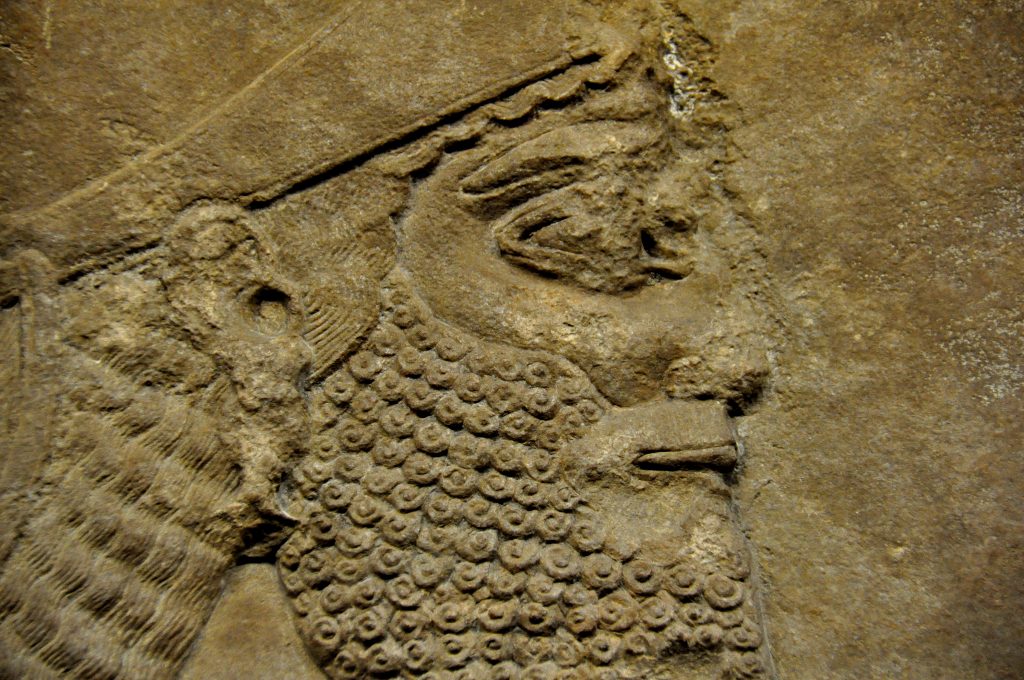
Head of Ashurnasirpal II, detail of a large stone panel where the king was portrayed twice. From Room B, Panel 23, the North-West Palace at Nimrud (ancient Kalhu), Mesopotamia, modern-day Iraq. Room B was the “Throne Room” and this relief was placed behind the King’s throne. Neo-Assyrian Period, 865-860 BCE. Housed in the British Museum, London. Photo © Osama S. M. Amin.
How to portray the owner of this Palace, Ashurnasirpal II? After all, it is a one-man show conducted by a ruthless King! Sculptors had to work closely with architects. But, there is another group, composed of priests, diviners, and magicians, who had to be involved! The latter team had to ensure that the supernatural realm and magical spirits were placed in their appropriate locations, so that they can ward off evils and offer the best protection to the King and his Palace.
Room 7 on the ground floor of the British Museum is part of the marvellous Assyrian Galleries. If you ever visit this room, you must consider yourself part of something timeless. Thanks to the great work of Sir Henry Layard and his workmen, any person from any part of the globe can enjoy the scent of history and appreciate with their own eyes these astonishing masterpieces from Nimrud.
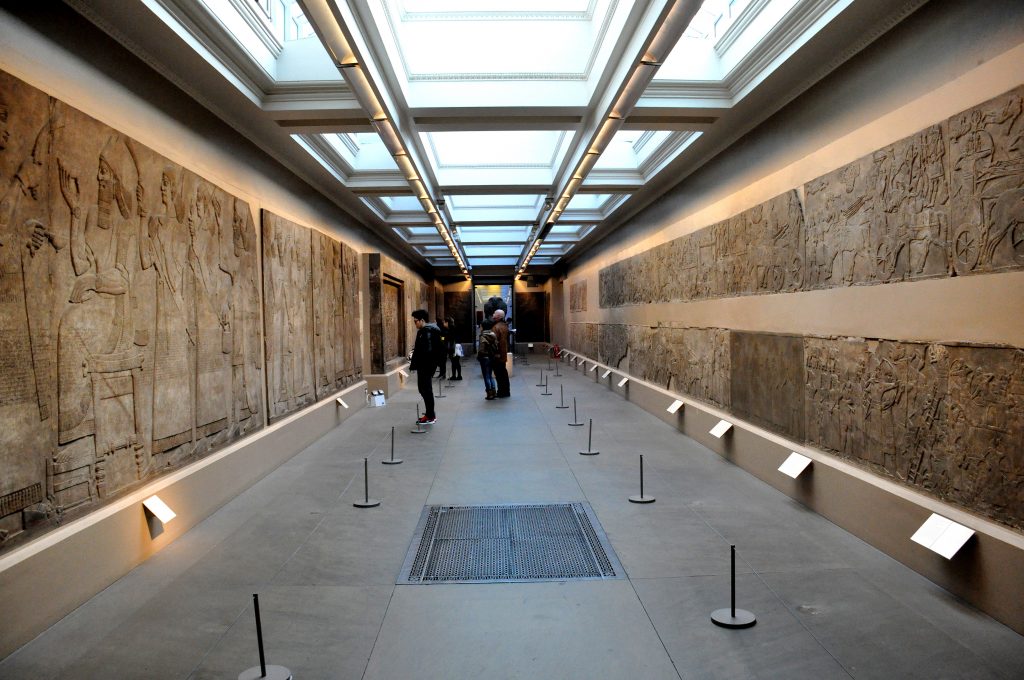
Assyria: Nimrud. Room 7, Grand Floor, the British Museum, London. Alabaster bas-reliefs from the North-West Palace at Nimrud decorate this gallery. The reliefs came from different rooms of the Palace. On the left, the reliefs are 2-meter high and depict various ceremonial rituals performed by Ashurnasirpal II, accompanied by royal attendants and various Apkallus. On the right, the reliefs are composed of 2 horizontal registers or parallel rectangular slabs, narrating war scenes and lion-hunts led by the king; the space in between those reliefs was filled in by the “Standard Inscription of Ashurnasirpal II” and this was removed intentionally by Sir Henry Layard to lessen their weight during transportation to England. Photo © Osama S. M. Amin.
There are 2 types of slabs housed in Room 7. On the right side, Ashurnasirpal engages in victorious war scenes and dangerous lion hunting activities; I will be discussing these in another article. Here, I will be addressing a multitude of 2-meter high courtly and ritual ceremonial scenes of the King himself, not the guardians and not the protective spirits. It’s all about the King, Ashurnasirpal II (reigned 883-859 BCE), and nothing but the King.
The left side of the gallery is decorated with complete slabs, and sometimes, fragments of these slabs. The image of the King can be found 9 times. The King was portrayed twice within one complete scene within a large stone wall panel, which was found behind the throne. There is a small square-shaped fragment depicting the King’s head only; this was purchased by the British Museum. The King and a royal attendant appear in a horizontal rectangular fragment of a large slab; the lower part of this slab is housed in another museum. Therefore, the King’s whole image appears in 6 complete large wall panels.
Ashurnasirpal II was depicted either standing (6 times) or sitting. In one slab, he sits on his throne in a courtly ritual scene; this sitting posture is found once only. Two slabs depict the King standing; a conqueror holding arrows and bow or holding a long royal staff and putting his hand on his sword’s hilt. In the remaining panels, he appears to perform ceremonial rituals. Depending on the type of the scene, royal guards or attendants (with their full weaponry) stand before and behind the king, sometimes waving fly-whisks. Apkallu spirits have to protect the environment; they may immediately flank the king, or flank the group of the king and his royal guards.
Once again, it’s all about the King. I will not post “complete full front” pictures of all slabs; you can find these throughout the internet, quite easily. But rather, I will concentrate, using what you may call a semi-microscope, to highlight small unrecognized details of the King, which make this article unique!
A master sculptor initially made the general sketching or incisions on the slab. Then, a group of different sculptors, working under the supervision of lead artists, worked on the slabs. This was clearly reflected by the different depictions (or iconographies) of the same subject; for example Ashurnasirpal II’s face and head details.
Because many people just watch the slabs rapidly, the King may appear to the audience as a copy-paste figure. No, the King’s attire, royal regalia, headdress, sandals, and so on all appear differently carved, with different shapes, hair style, etc. For instance, the Kings facial expression may look rigid, full of terror, poker-faced, or in one image, as if he is smiling!
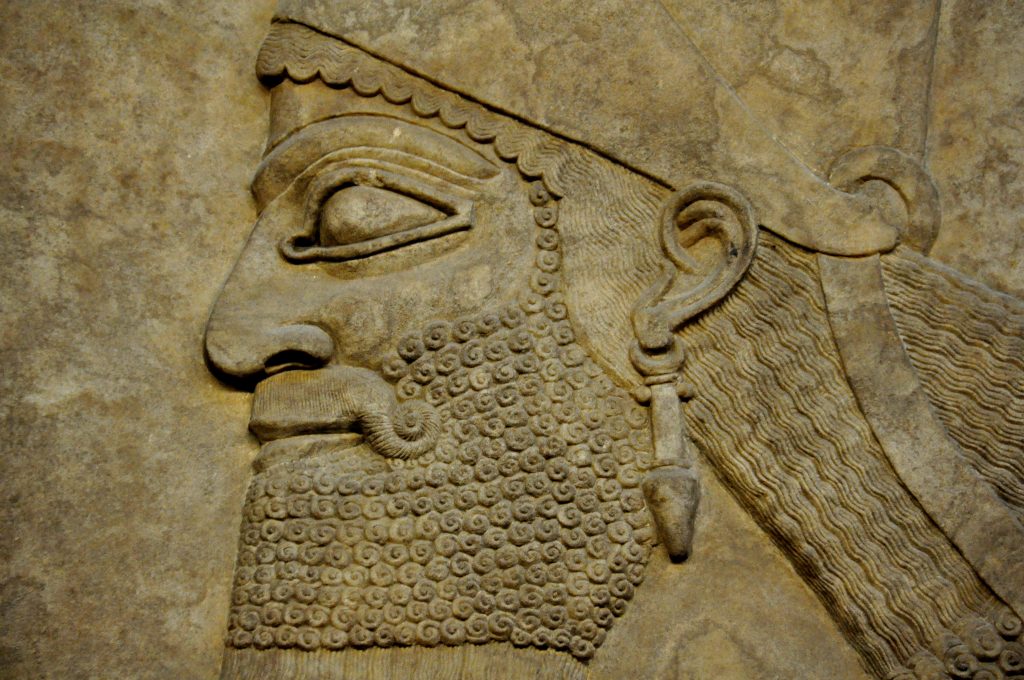
Head of Ashurnasirpal II, detail of a relief. From Room G, Panel 3, the North-West Palace at Nimrud (ancient Kalhu), Mesopotamia, modern-day Iraq. This room was part of the “East Suite”, where the King performed prayers and ceremonial rituals and only high-ranking advisors and temple priests have access to this room. Neo-Assyrian Period, 865-860 BCE. Housed in the British Museum, London. Photo © Osama S. M. Amin.
The sculptors “took different pictures” of the King, on different days, and on different occasions and put them in an album of stone images. Despite being out of context here in the British Museum, these reliefs undoubtedly make a lasting impression on the visitors today as they did in the past. What a talent!
When seeing the images, please do more than just watch; spend some time, scan the details, compare them with other images of the same subject, and absorb the content! For example, the King’s face and head, look at the general facial expression, the jaw position, eye, scalp hair as well as its style and arrangement, the beard, the mustache, the garment embroidery, etc.
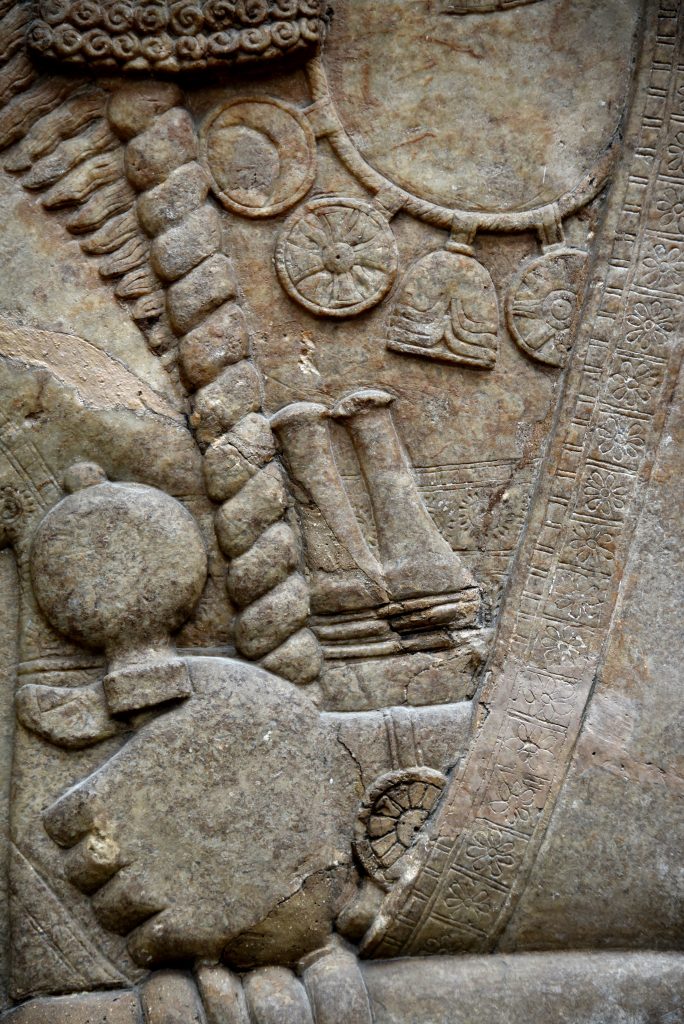
The king was portrayed from the left side. He wears a necklace carrying divine symbols; from left to right, Sin, Shamash, Ashur, and Ishtar. The king’s left arm is underneath an elegant garment, which covers the left shoulder, like a rope. He wears a bracelet with a rosette and holds a mace (symbol of authority). Two daggers inside their sheathes were tucked into the waist band. The dress was exquisitely carved with rosette motifs. The arrangement of the components of this part of the relief depicted in a very talented 3-dimentional space. Detail of a large relief from Room B, Panel 23, the North-West Palace at Nimrud (ancient Kalhu), Mesopotamia, modern-day Iraq. Room B was the “Throne Room” and this relief was placed behind the King’s throne. Neo-Assyrian Period, 865-860 BCE. Housed in the British Museum, London. Photo © Osama S. M. Amin.
At the end of my visit, I stood aside, as I had gotten exhausted. A young British man (his accent was clearly diagnostic) with a young girl of five or six years in age came in and watched the slabs. His words were carved into my mind; he said to this girl:
“You see these gigantic men and flying creatures? Remember when your daddy, a soldier, told you that he served several months in Iraq… these came from Iraq… many many years ago… a great civilization and a great people”.
Enjoy the images!
“Fashions fade, style is eternal”, Yves Saint Laurent.

Head of Ashurnasirpal II, detail of a relief. From the head of Room S, Panel 3, the North-West Palace at Nimrud (ancient Kalhu), Mesopotamia, modern-day Iraq. Room S was the King’s private area, and part of the “South Suite”. Neo-Assyrian Period, 865-860 BCE. Housed in the British Museum, London. Photo © Osama S. M. Amin.
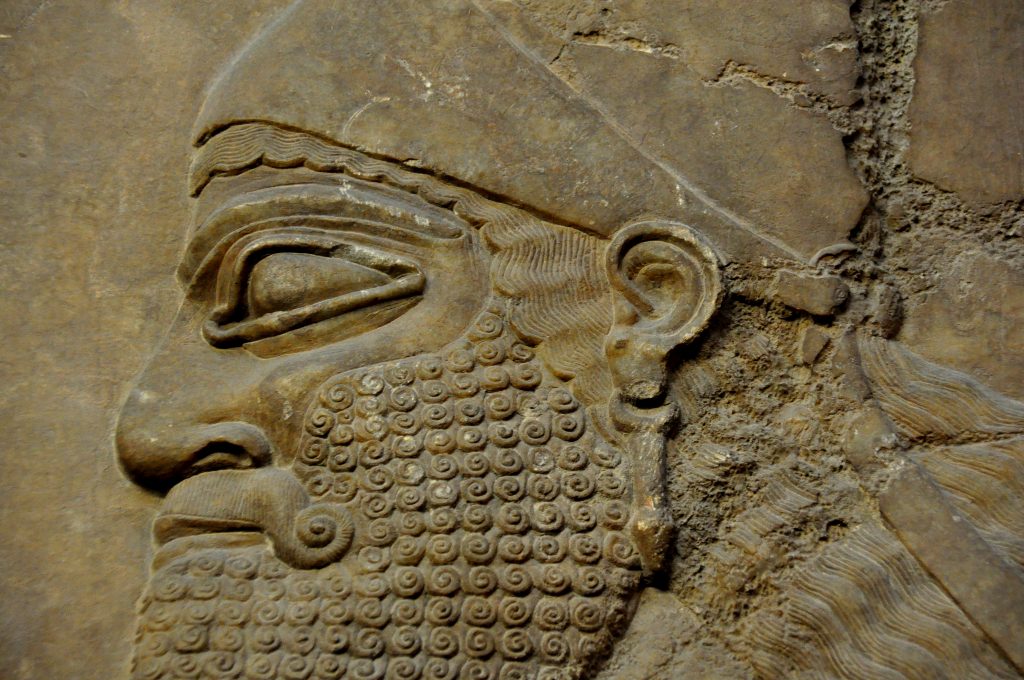
Head of Ashurnasirpal II, detail of a relief. From Room G, Panel 25, the North-West Palace at Nimrud (ancient Kalhu), Mesopotamia, modern-day Iraq. This room was part of the “East Suite”, where the King performed prayers and ceremonial rituals and only high-ranking advisors and temple priests have access to this room. Neo-Assyrian Period, 865-860 BCE. Housed in the British Museum, London. Photo © Osama S. M. Amin.
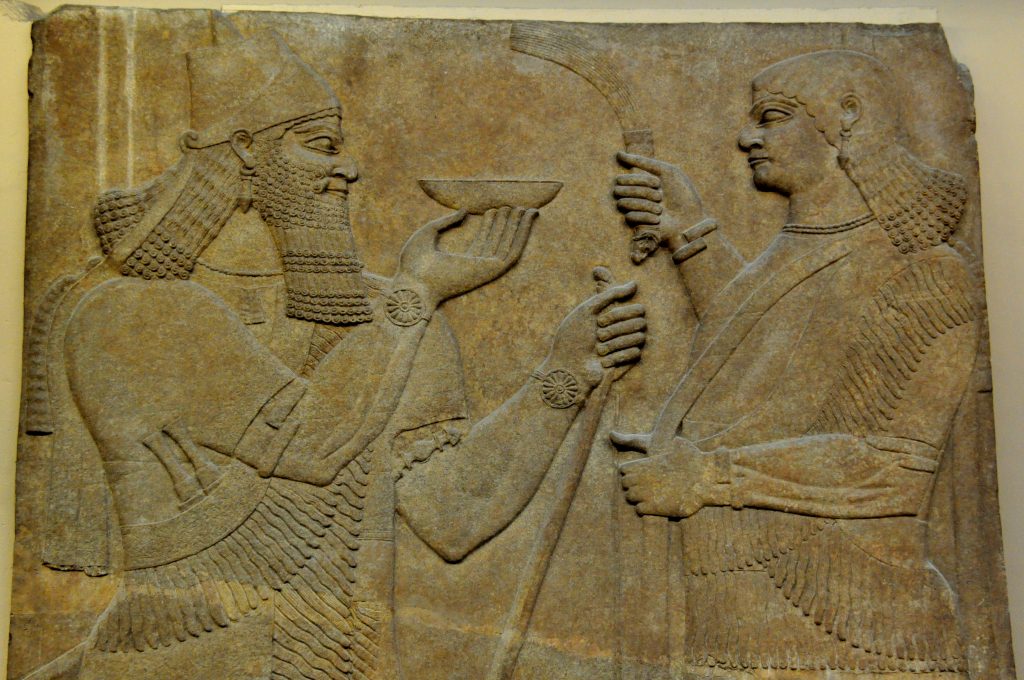
Ashurnasirpal II holding a bowl, detail of a relief. Note the King’s facial expression, headgear, hair, earring, necklace, mustache, beard, wrist bracelet, armlets, daggers, and the bowl he holds with his right hand. The left hand holds a long royal staff. The King’s attire is superb. What is unusual in this scene is that the King’s royal attendant is “taller” than the King himself! From Room G, Panel 10, the North-West Palace at Nimrud (ancient Kalhu), Mesopotamia, modern-day Iraq. This room was part of the “East Suite”, where the King performed prayers and ceremonial rituals and only high-ranking advisors and temple priests have access to this room. Neo-Assyrian Period, 865-860 BCE. Housed in the British Museum, London. Photo © Osama S. M. Amin.
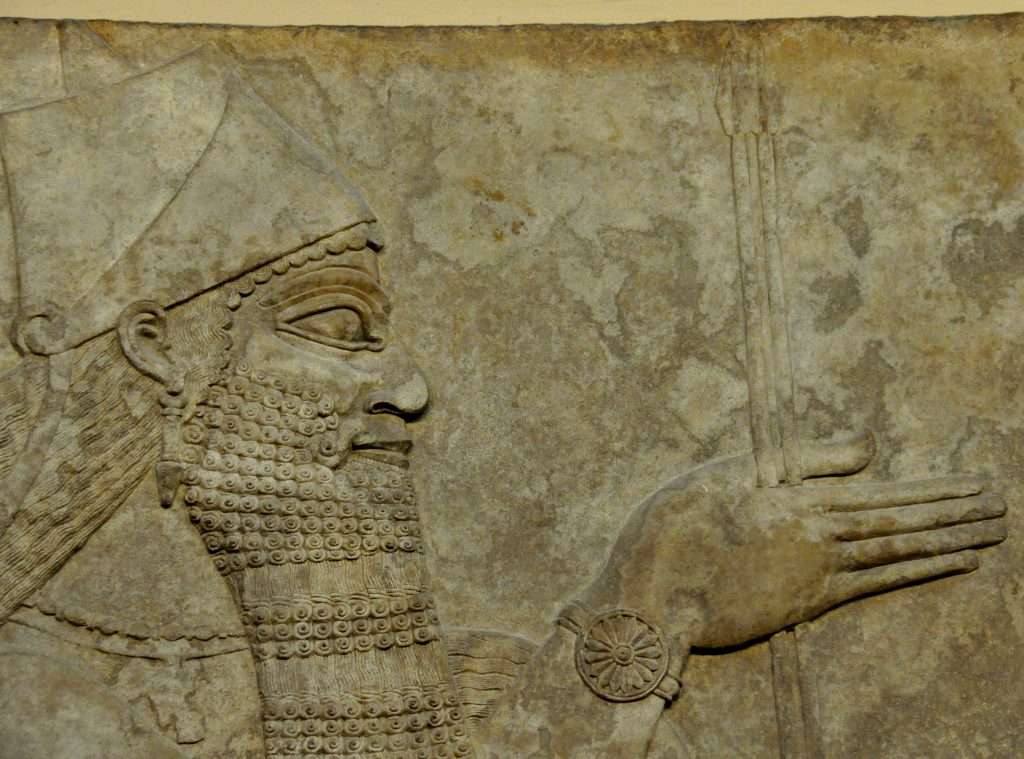
Head of Ashurnasirpal II. The king holds arrows (and a bow, not shown); he was depicted as a conqueror. From Room G, Panel 6, the North-West Palace at Nimrud (ancient Kalhu), Mesopotamia, modern-day Iraq. This room was part of the “East Suite”, where the King performed prayers and ceremonial rituals and only high-ranking advisors and temple priests have access to this room. Neo-Assyrian Period, 865-860 BCE. Housed in the British Museum, London. Photo © Osama S. M. Amin.
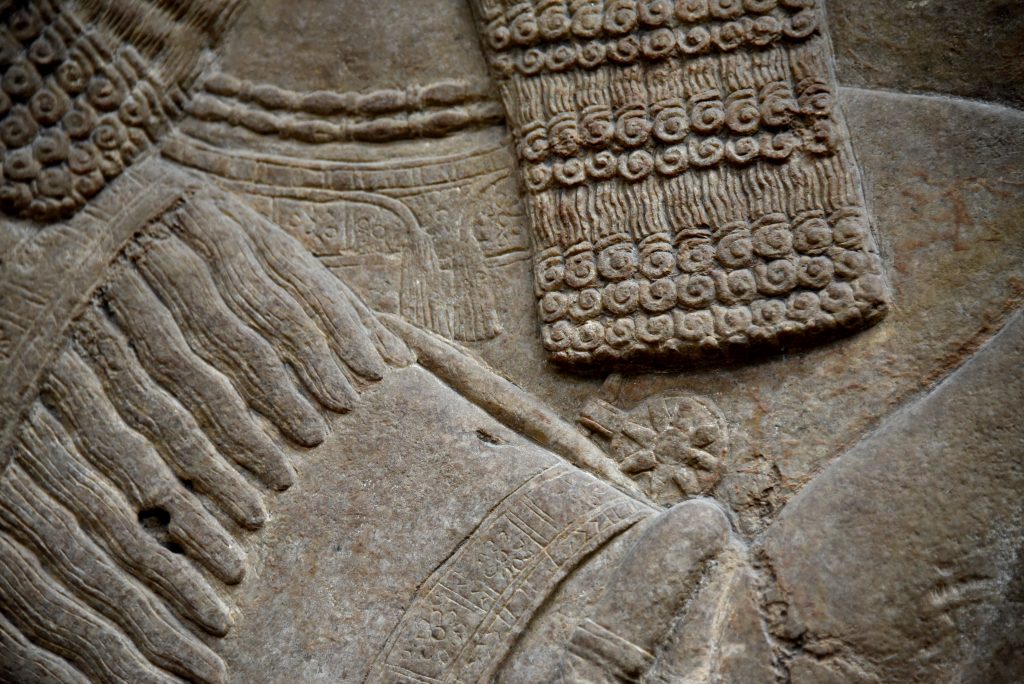
Because the king was portrayed from the right side, the necklace he wears on the upper chest was obscured by the right upper limb; only part of the necklace carrying the symbol of goddess Ishtar appears. At the lower neck, there is a double-beaded necklace. Note the embroidered rosettes on the dress and the fringes of the garment. An armlet appears just above the right elbow joint. The king’s beard is thick and there are horizontal layers of curls. Detail of a large relief. From Room B, Panel 23, the North-West Palace at Nimrud (ancient Kalhu), Mesopotamia, modern-day Iraq. Room B was the “Throne Room” and this relief was placed behind the King’s throne. Neo-Assyrian Period, 865-860 BCE. Housed in the British Museum, London. Photo © Osama S. M. Amin.
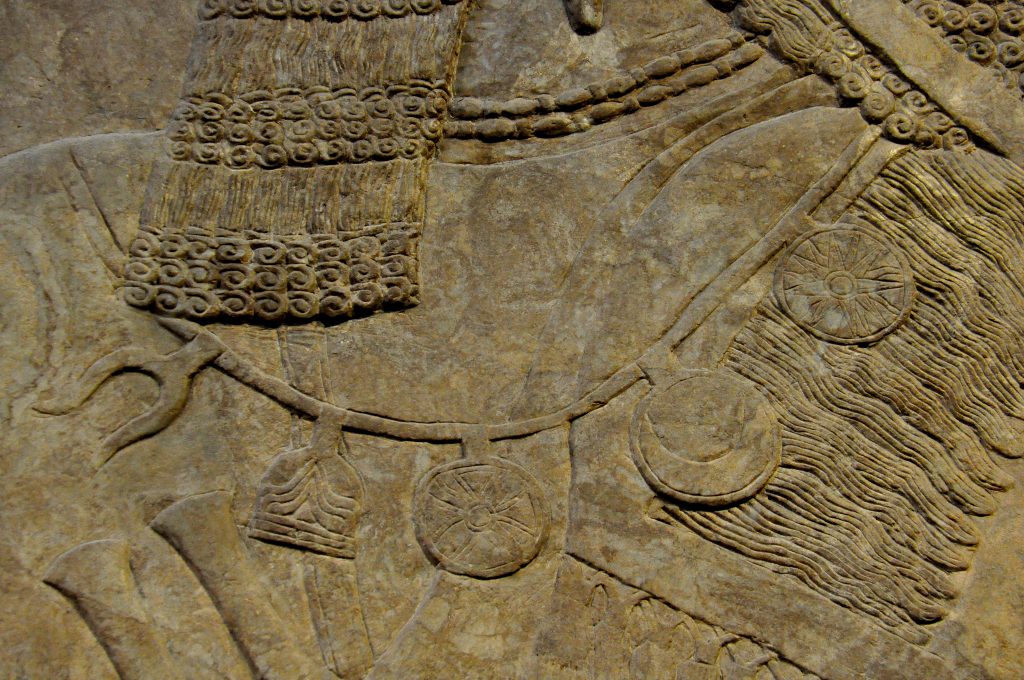
Ashurnasirpal II stands and is flanked by two eagle-headed Apkallus (not shown). This detail of the alsb shows that the king wears a necklace hanging in front the upper chest and carrying 5 divine symbols; from left to right, Adad, Ashur, Shamash, Sin, and Ishtar. At the lower neck, there is a double-beaded necklace. Note the fringed margin of the garment (rope). The two daggers’ handles also appear on the left, where they were tucked into the waist band. Detail of a large relief. From Room F, Panels 4, the North-West Palace at Nimrud (ancient Kalhu), Mesopotamia, modern-day Iraq. Room F (which was adjacent to the Throne Room B) was a place for the king to rest, either before or after he met people in the Throne Room. Neo-Assyrian Period, 865-860 BCE. Housed in the British Museum, London. Photo © Osama S. M. Amin.

Two daggers within their sheathes were tucked into the obliquely dangling fringed royal garment. The embroidery is interesting. Two animals (goat or deer) are approaching a palm tree; this “scene was commonly found, carved on many Nimrud Ivories (see this image of mine of an ivory plaque from Nimrud in the Sulaymaniyah Museum). From Room G, Panel 10, the North-West Palace at Nimrud (ancient Kalhu), Mesopotamia, modern-day Iraq. This room was part of the “East Suite”, where the King performed prayers and ceremonial rituals and only high-ranking advisors and temple priests have access to this room. Neo-Assyrian Period, 865-860 BCE. Housed in the British Museum, London. Photo © Osama S. M. Amin.
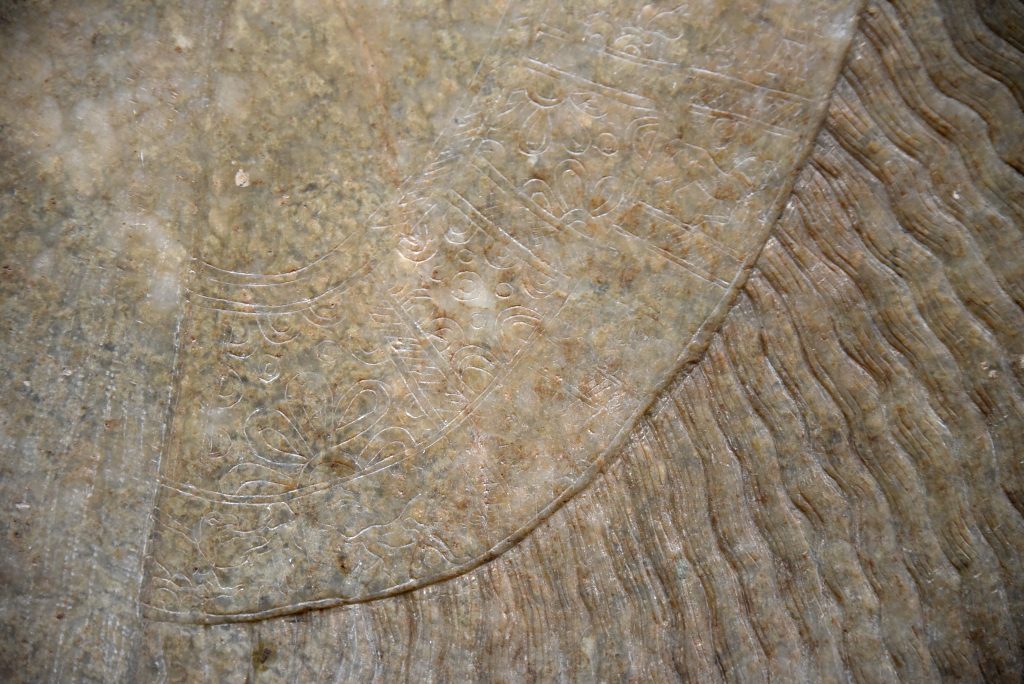
Detail of Ashurnasirpal II’s royal garment. There are 2 curved bands of embroidery. The upper one is wider than the lower one and was embroidered with half-rosettes and their petals. On the lower band, and on the left, one we can recognize a large bird (seems to be an eagle?) outstretching his wings in front of a standing figure (human?) who outstretches his arms to approach that bird; on the right, a standing/striding animal (lion?) is found. Note the dangling fringes. Detail of a relief. From the head of Room S, Panel 3, the North-West Palace at Nimrud (ancient Kalhu), Mesopotamia, modern-day Iraq. Room S was the King’s private area, and part of the “South Suite”. Neo-Assyrian Period, 865-860 BCE. Housed in the British Museum, London. Photo © Osama S. M. Amin.
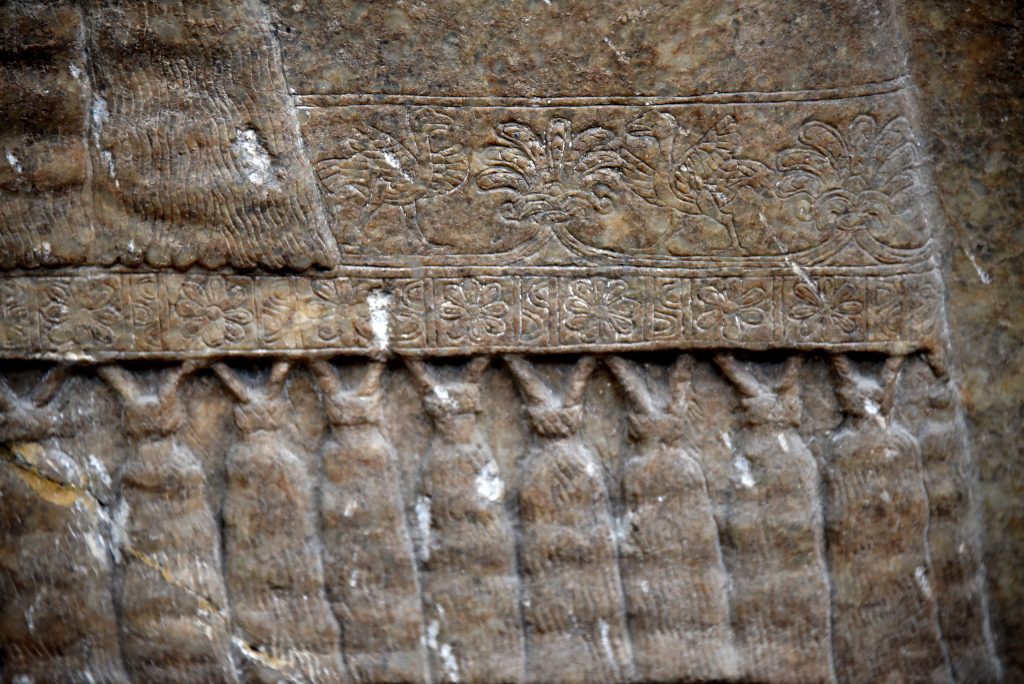
This is the lower end of a royal garment of Ashurnasirpal II, just above the left ankle. The upper band of embroidery shows a sacred/palm tree flanked by 2 standing/striding ostriches with their outstretched wings. On the lower band, there are embroidered rosette motifs. Note the tassels of the garment. From Room G, Panel 10, the North-West Palace at Nimrud (ancient Kalhu), Mesopotamia, modern-day Iraq. This room was part of the “East Suite”, where the King performed prayers and ceremonial rituals and only high-ranking advisors and temple priests have access to this room. Neo-Assyrian Period, 865-860 BCE. Housed in the British Museum, London. Photo © Osama S. M. Amin.
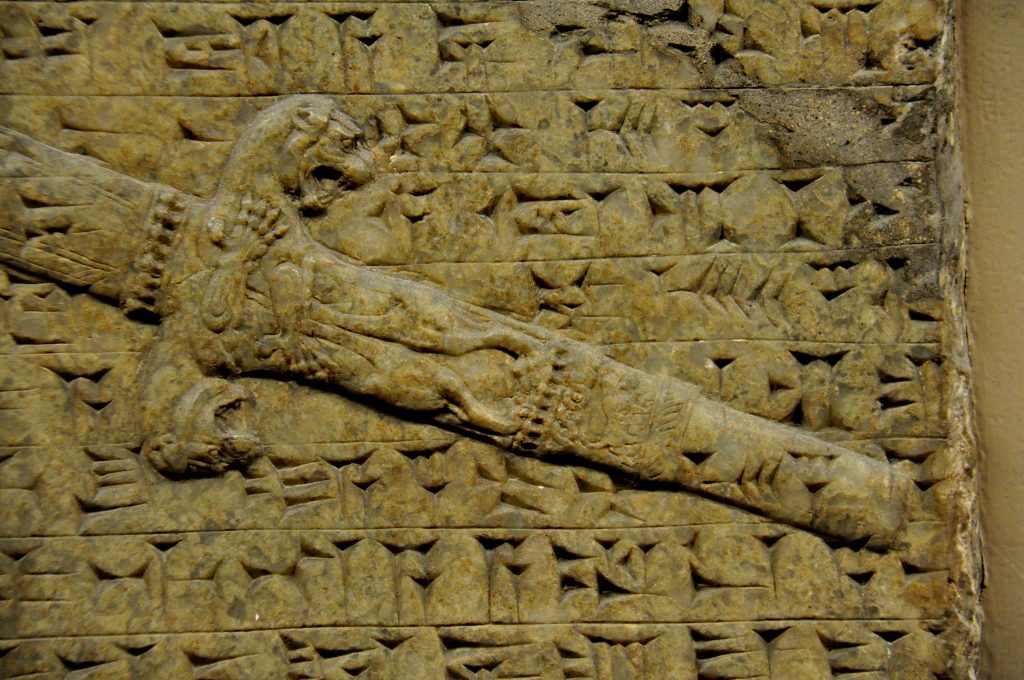
The lower end of the scabbard of Ashurnasirpal II’s sword. This part was exquisitely carved with 2 standing roaring lionesses, hugging each other. Note the carved cuneiform text of the “Standard Inscription” Detail of a relief. From the head of Room S, Panel 3, the North-West Palace at Nimrud (ancient Kalhu), Mesopotamia, modern-day Iraq. Room S was the King’s private area, and part of the “South Suite”. Neo-Assyrian Period, 865-860 BCE. Housed in the British Museum, London. Photo © Osama S. M. Amin.

The left hand of Ashurnasirpal II rests on a sword’s hilt. The hilt is in between the proximal part of the palmar surface of the left thumb and the index finger (note that the upper part of the hilt is obscured). There is a bracelet encircling the left wrist, with a rosette. Figures and motifs of rosettes were commonly used in the Assyrian art; a sign of good luck and protection. Note that the “Standard Inscription” of Ashurnasirpal II does not cover the King’s fingers and sword’s hilt. Detail of a relief. From the head of Room S, Panel 3, the North-West Palace at Nimrud (ancient Kalhu), Mesopotamia, modern-day Iraq. Room S was the King’s private area, and part of the “South Suite”. Neo-Assyrian Period, 865-860 BCE. Housed in the British Museum, London. Photo © Osama S. M. Amin.
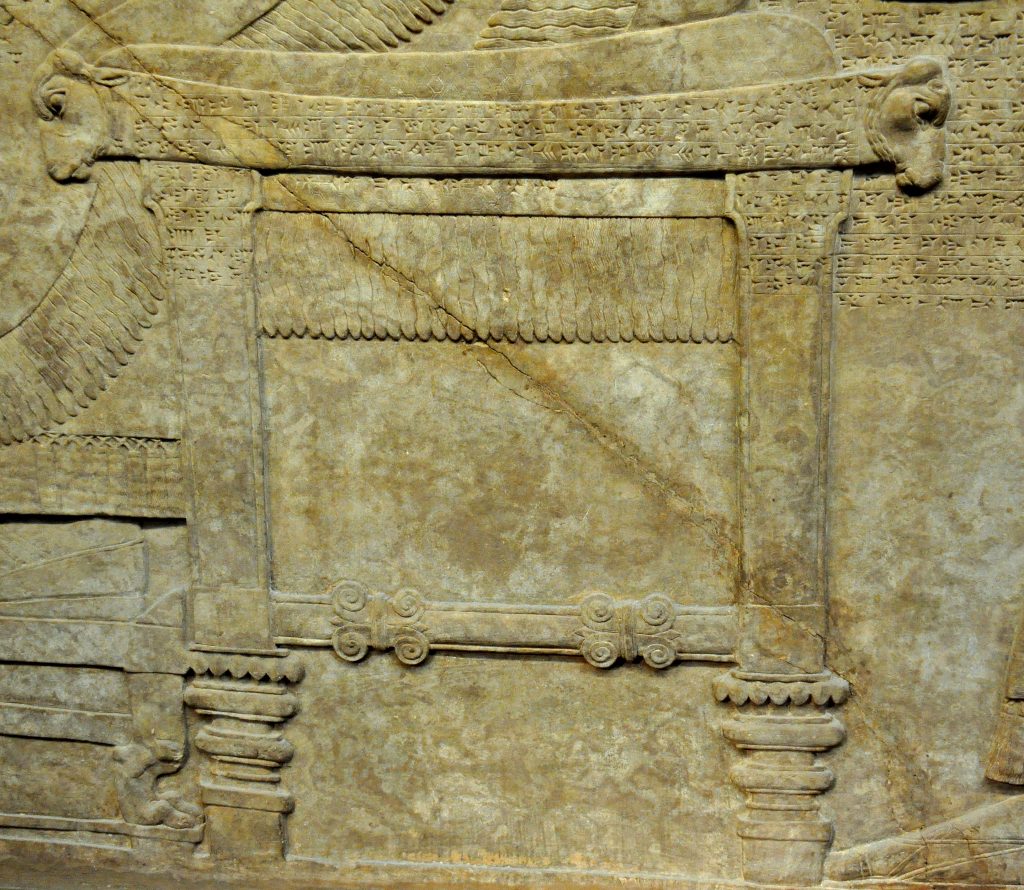
Detail of Ashurnasirpal II’s throne. This throne was made of special type of wood (might be cedar). A ram’s (or calf’s) head decorates both, the front and the back of the throne’s seat. Above it, a cushion can be recognized, covered with a textile embroidered with hexagonal motifs. The king sits on the throne and his left foot (wearing a sandal) rests on a footstool; the stool’s legs are in the shape of a lion’s paw. The rams’ heads are free of cuneiform inscriptions (to highlight their wonderful details). Thrones were inlaid with carved ivories and precious stones. From Room G, Panel 3, the North-West Palace at Nimrud (ancient Kalhu), Mesopotamia, modern-day Iraq. This room was part of the “East Suite”, where the King performed prayers and ceremonial rituals and only high-ranking advisors and temple priests have access to this room. Neo-Assyrian Period, 865-860 BCE. Housed in the British Museum, London. Photo © Osama S. M. Amin.
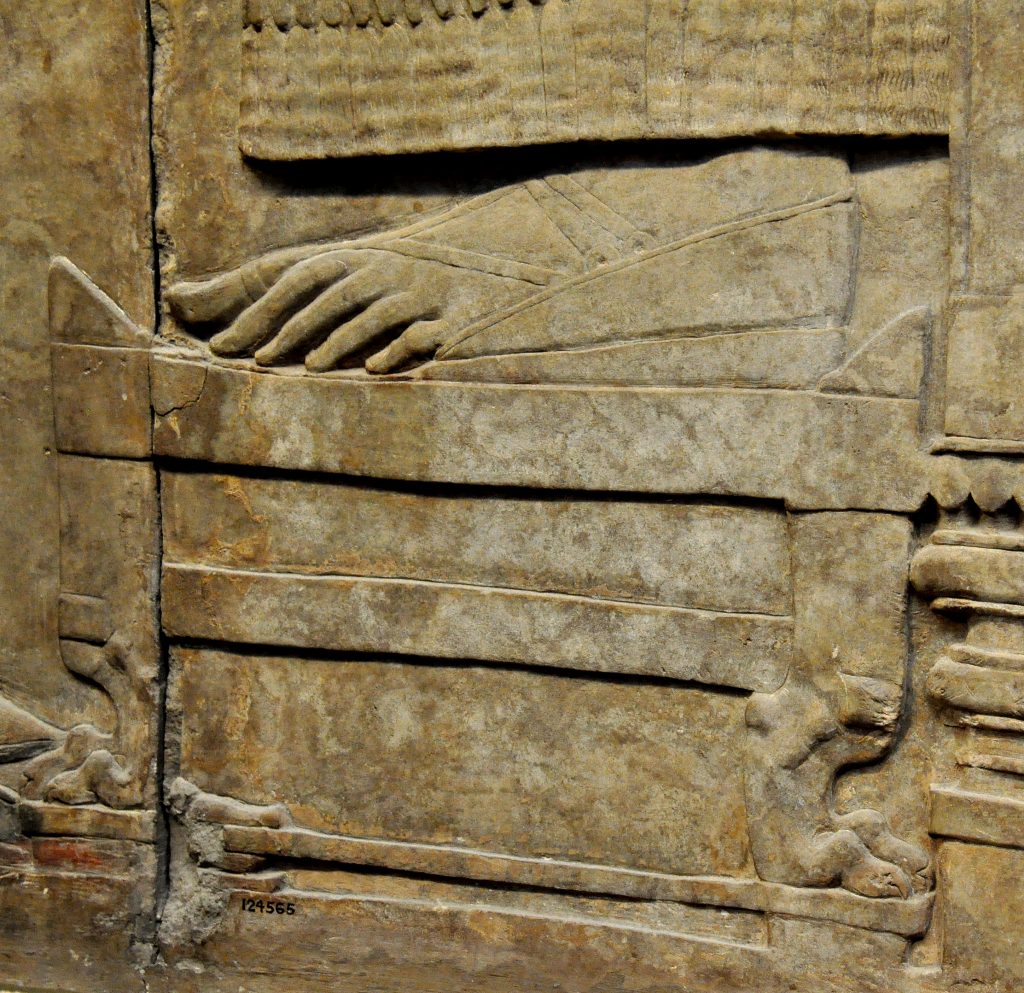
Detail of Ashurnasirpal II’s footstool; the stool’s legs were carved in the shape of a lion’s paw. The king’s left foot (wearing a sandal) rests on the footstool. Note the traces of the original colors at the left lower corner. Thrones and footstools were inlaid with carved ivories and precious stones. From Room G, Panel 3, the North-West Palace at Nimrud (ancient Kalhu), Mesopotamia, modern-day Iraq. This room was part of the “East Suite”, where the King performed prayers and ceremonial rituals and only high-ranking advisors and temple priests have access to this room. Neo-Assyrian Period, 865-860 BCE. Housed in the British Museum, London. Photo © Osama S. M. Amin.
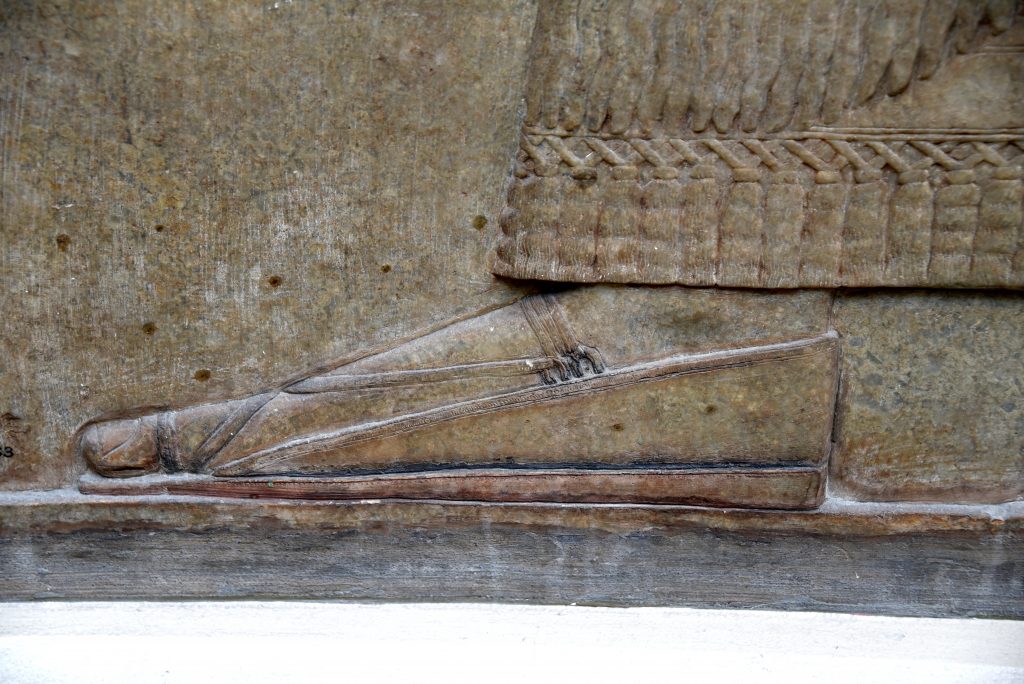
Ashurnasirpal II’s right foot. He wears a sandal. The original traces of red and black colors on the sandal are seen. Such sandals were made of leather or reeds; sandals were the commonest type of footwear in ancient Mesopotamia. Note the proximal 3 mid-foot straps, the single distal big toe strap, the heel’s height, and the height of the sole of the sandal. Detail of a relief. From the head of Room S, Panel 3, the North-West Palace at Nimrud (ancient Kalhu), Mesopotamia, modern-day Iraq. Room S was the King’s private area, and part of the “South Suite”. Neo-Assyrian Period, 865-860 BCE. Housed in the British Museum, London. Photo © Osama S. M. Amin.

Ashurnasirpal II’s right foot. He wears a sandal. Sandals were the commonest type of footwear in ancient Mesopotamia. Note the proximal 3 mid-foot straps, the single distal big toe strap, the heel’s height, and the height of the sole of the sandal. Around the bony prominence of the ankle (medial malleolus), there is circular cord-like band which extends to the mid-foot straps; this might be part of the sandal’s straps or a superficial skin vein. The overall shape of the sandal is different from the above one (in the previous image). Detail of a large relief. From Room B, Panel 23, the North-West Palace at Nimrud (ancient Kalhu), Mesopotamia, modern-day Iraq. Room B was the “Throne Room” and this relief was placed behind the King’s throne. Neo-Assyrian Period, 865-860 BCE. Housed in the British Museum, London. Photo © Osama S. M. Amin.
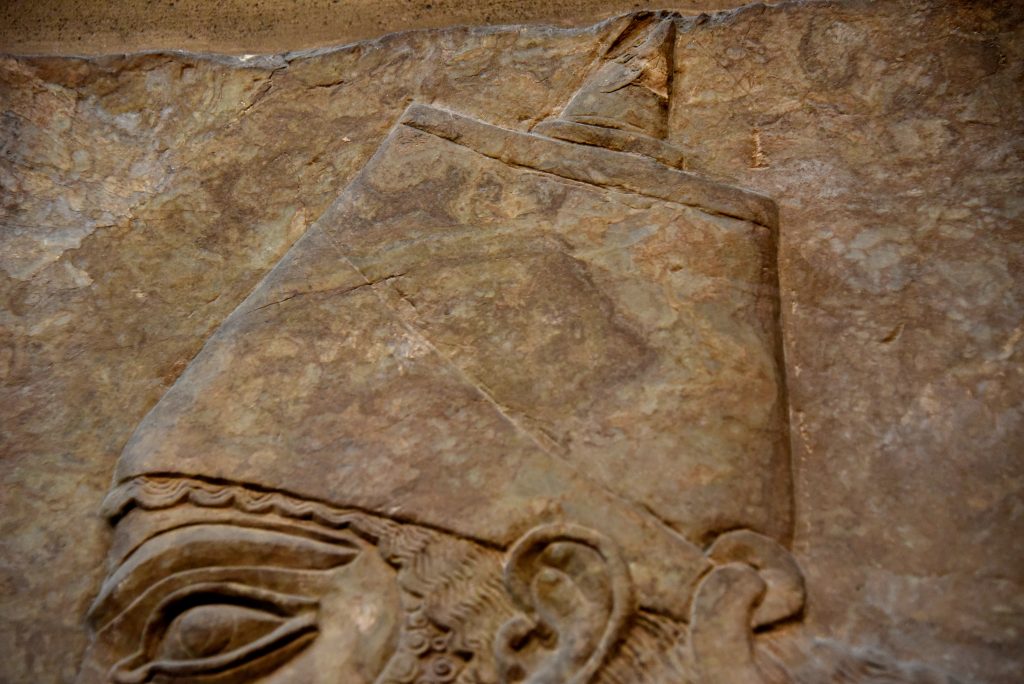
Ashurnasirpal II’s headdress. It is a conical cap, narrower at the top, which has a small central pointed conical protrusion. The cap is wrapped with a turban. At the back of the cap, a long narrow piece of embroidered cloth is attacked and hangs down to the mid-back. The headdress is called “polos” and its attached cloth is called “lapets”. The king’s polos covers the head, leaving both ears clearly recognized. The scalp hair at the frontal area is obvious below the lower margin of the cap/turban. Note how the knot of the lapets was made and the scalp hair arrangement, just in front of the left ear. From Room F, Panels 4, the North-West Palace at Nimrud (ancient Kalhu), Mesopotamia, modern-day Iraq. Room F (which was adjacent to the Throne Room B) was a place for the king to rest, either before or after he met people in the Throne Room. Neo-Assyrian Period, 865-860 BCE. Housed in the British Museum, London. Photo © Osama S. M. Amin.
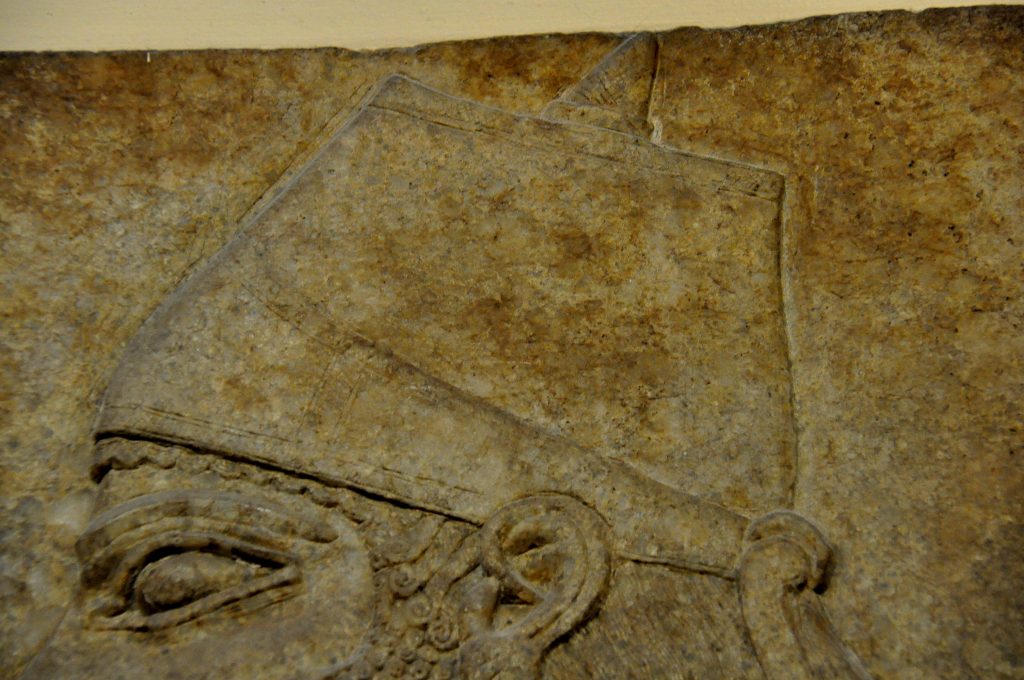
Ashurnasirpal II’s polos (headdress). Note that the turban of this cap is different from that of the image above. The headdress is called “polos” and its attached cloth is called “lapets”. The king’s polos covers the head, leaving both ears clearly recognized. The scalp hair at the frontal area is obvious below the lower margin of the cap/turban. Note how the knot of the lapets was made. There are (what appear to be 3 or 4) braids of hair in front of the left ear; this style is different from the image above. From the head of Room S, Panel 3, the North-West Palace at Nimrud (ancient Kalhu), Mesopotamia, modern-day Iraq. Room S was the King’s private area, and part of the “South Suite”. Neo-Assyrian Period, 865-860 BCE. Housed in the British Museum, London. Photo © Osama S. M. Amin.

Two alabaster slabs, carved in low relief; height 236.22 cm. They depict a magnificent formal court scene. Ashurnasirpal II sits on his throne. His legs and feet (wearing sandals) rest on a footstool. The King holds a ceremonial bowl (filled with wine or another type of fluid) using his right hand; his left arm and hand rest on his left thigh. Three royal attendants stand before (one) and behind the King (two). Two of them are waving fly whisks, so that nothing, not even little creatures buzzing around in the air, could disturb the king’s tranquility. The attendant before the king holds a bowl and offers wine to the King; he does not bear any weapon. The two attendants behind the king hold their royal weapons (sward, bow, quivers, and arrows); the very far one holds a mace with his right hand. The scene is flanked by two human-headed and winged Apkallus (not shown) to ward off evil spirits. From Room G, Panels 2 and 3, the North-West Palace at Nimrud (ancient Kalhu), Mesopotamia, modern-day Iraq. This room was part of the “East Suite”, where the King performed prayers and ceremonial rituals and only high-ranking advisors and temple priests have access to this room. Neo-Assyrian Period, 865-860 BCE. Housed in the British Museum, London. Photo © Osama S. M. Amin.
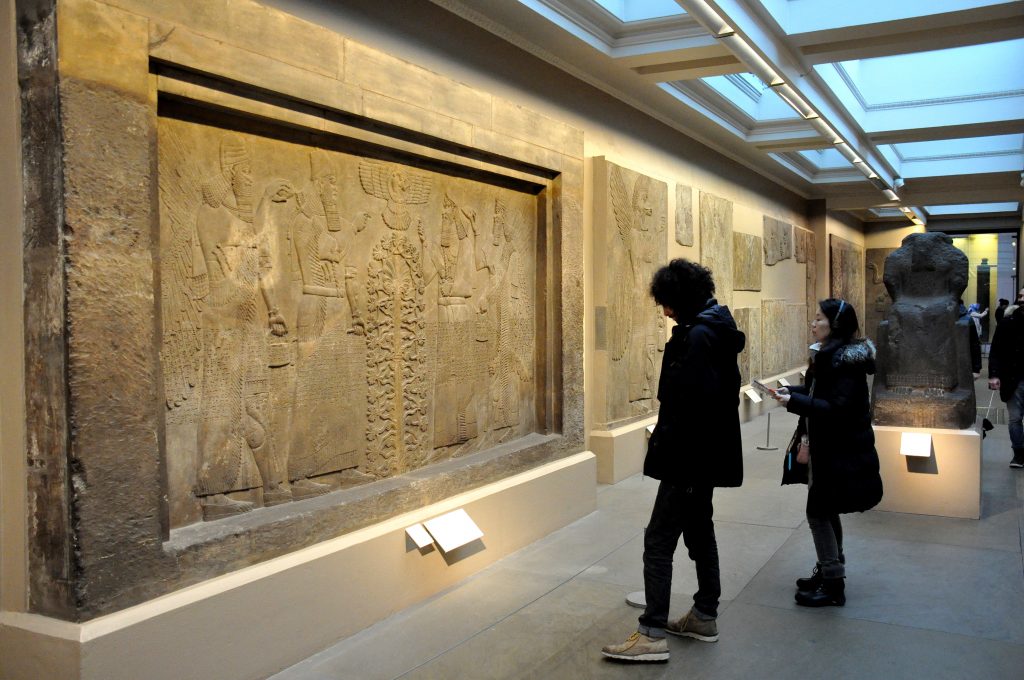
Two visitors of the British Museum stand before a large framed wall panel; maximum dimensions of 195 cm (height) x 432.8 cm (width). This scene was found in Room B (Throne Room) behind the King’s throne area. There is central “Sacred Tree” (symbolizing life). Ashurnasirpal II was depicted twice, portrayed from right and left, in a magnificent way, standing before the Tree, wearing his full royal attire and accessories, and making a gesture of worship (using the thumb and index fingers) to the sun god Shamash (depicted above the tree). The King is protected by 2 Apkallus. This panel was shipped to England in 5 cases, in 2 shipments, and on different ships. A very similar scene was left in situ at Nimrud and was destroyed by ISIS in early 2015. From Room B, Panel 23, the North-West Palace at Nimrud (ancient Kalhu), Mesopotamia, modern-day Iraq. Neo-Assyrian Period, 865-860 BCE. Housed in the British Museum, London. Photo © Osama S. M. Amin.
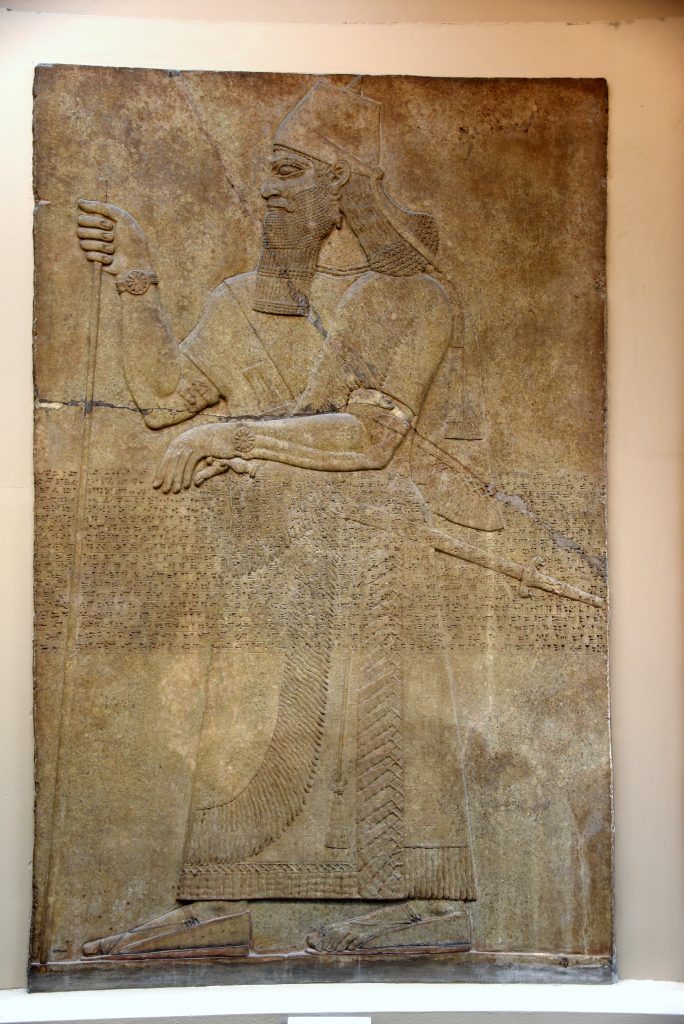
Finally, I intentionally chose this image which shows the wall relief complete and en face to conclude the article. The King stands majestically, facing left in a sharp terrorizing look and eye, resting his left hand on his sword’s hilt, grasping a royal staff with his right hand, and wearing the full marvelous royal garment (indescribable embroidery) and accessories. The image speaks on the behalf of its owner! The relief was flanked by two Apkallus (these two Apkallu reliefs are now housed in New York and New Haven). Note the traces of red and black colors on the King’s sandals. From the head of Room S, Panel 3, the North-West Palace at Nimrud (ancient Kalhu), Mesopotamia, modern-day Iraq. Room S was the King’s private area, and part of the “South Suite”. Neo-Assyrian Period, 865-860 BCE. Housed in the British Museum, London. Photo © Osama S. M. Amin.

